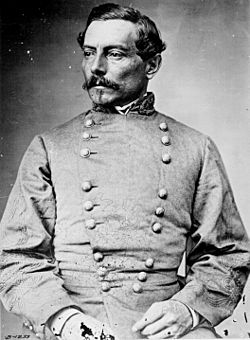Army of the Potomac (Confederate) facts for kids
Quick facts for kids Army of the Potomac |
|
|---|---|

P. G. T. Beauregard
|
|
| Active | April 1861 – March 14, 1862 |
| Country | |
| Branch | |
| Role | Confederate army in Eastern Theater |
| Engagements | American Civil War |
| Commanders | |
| Notable commanders |
P.G.T. Beauregard Joseph E. Johnston |
The Army of the Potomac was a group of soldiers from the Confederate States Army during the early part of the American Civil War. It was led by P. G. T. Beauregard, a high-ranking officer. This army didn't exist for very long.
Its most important fight was the First Battle of Bull Run. After this battle, another group of soldiers, the Confederate Army of the Shenandoah, joined the Army of the Potomac. Joseph E. Johnston, who led the Shenandoah army, then took charge of the combined forces. On March 14, 1862, the Army of the Potomac was renamed the Army of Northern Virginia. Beauregard's original soldiers eventually became part of the First Corps, Army of Northern Virginia.
Contents
History of the Confederate Army of the Potomac
How the Army Was Formed
The Army of the Potomac was created from different Confederate groups in northeastern Virginia. These groups arrived between April and July 1861. At first, Philip St. George Cocke was put in charge of the area along the Potomac River. His job was to gather local volunteer groups into the Confederate army.
Soldiers from Alabama, Georgia, Louisiana, Mississippi, and South Carolina also came to Virginia. They were added to Cocke's command. On May 21, Milledge Luke Bonham replaced Cocke. Then, just ten days later, P. G. T. Beauregard took over.
Beauregard organized his army into six large groups called brigades. Two of these brigades were still led by Cocke and Bonham. Beauregard gathered his soldiers along the south side of Bull Run creek. His goal was to protect Manassas Junction, an important railway hub. More soldiers arrived in the following weeks, forming a seventh brigade. The brigade led by Theophilus Holmes also joined them.
Planning and Reinforcements
In his first few weeks, Beauregard sent plans to Confederate president Jefferson Davis. These plans were for an attack on Union forces in northern Virginia. Beauregard often suggested working with Joseph E. Johnston's Confederate Army of the Shenandoah. However, President Davis and his military advisor, Robert E. Lee, thought these plans wouldn't work.
On July 18, Union soldiers from the Army of Northeastern Virginia got close to Beauregard's positions. This Union army was led by Irvin McDowell. The Confederate War Department then ordered Johnston to move his army to help Beauregard. Johnston's soldiers arrived by train over the next few days.
Johnston was the highest-ranking officer there, so he took overall command of both Confederate armies. Beauregard had already made plans for an attack on the Union army's left side across Bull Run. He convinced Johnston to approve his plan. Johnston let Beauregard give the orders because Beauregard knew the area better.
The First Battle of Bull Run
The First Battle of Bull Run happened on July 21. Colonel Nathan George Evans's brigade from the Army of the Potomac started the fight on Matthews Hill. Two brigades from Johnston's army soon joined them.
As the battle moved to Henry House Hill, more soldiers joined the fight. Cocke's and Jubal Early's brigades, along with parts of Bonham's brigade from Beauregard's army, moved to the Confederate left side. The rest of Johnston's army also shifted there. Around 4 p.m., an attack by Early's brigade on the Union army's right side helped push the Union soldiers off the battlefield.
Beauregard's brigades lost fewer soldiers than Johnston's. However, some groups still lost as many as twenty out of every hundred soldiers. Most of Beauregard's brigades stayed on the Confederate right side. Beauregard still hoped to attack the Union army's left side. But because of confusing orders, some of which never reached the soldiers, the attack never happened. These brigades either didn't fight at all or only had small skirmishes. David Rumph Jones and James Longstreet crossed Bull Run and tried to organize an attack. But after a short fight, Jones's brigade was forced back by heavy artillery fire. Both brigades then went back across Bull Run.
After the Battle
After the battle, the two Confederate armies became one. It kept the name "Army of the Potomac," and Johnston remained in command. Beauregard was first made second-in-command. But he was soon moved to the Western Theater, another area of the war.
The army spread out across northern Virginia to watch the Union Army of the Potomac in Washington. They fought several small battles, including the Battle of Ball's Bluff. In the spring of 1862, Johnston's army moved to the Richmond area. There, the Army of the Peninsula and the Confederate soldiers in Norfolk, Virginia, joined them. At this time, during the Peninsula Campaign, the army was officially renamed the Army of Northern Virginia. However, Johnston continued to use the name Army of the Potomac until he was wounded.
See also
 In Spanish: Ejército del Potomac (confederado) para niños
In Spanish: Ejército del Potomac (confederado) para niños

